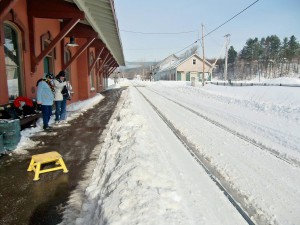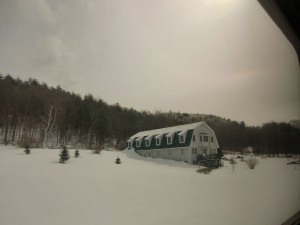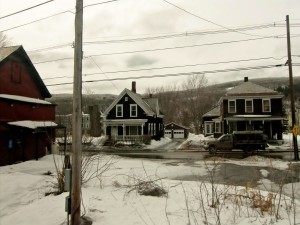IN SEARCH OF SNOW – LEAVING THE SNOW BELT
IN SEARCH OF SNOW
This is the 11th in a series of articles about traveling by rail in search of snow
LEAVING THE SNOW BELT
By Charles N. Stevens
Photos by Dolores Seidman
Soon after breakfast we board a bus that will take us to Waterbury, Vermont. The town seems half buried in snow, especially near the railroad station where we will wait for our train, the Vermonter. To escape the nippy air, we huddle in the warmth of the station’s waiting room. The railroad had been plowed, but the rails are only dark lines in the snow. The plow had pushed up long piles of snow on either side of the tracks. When the train arrives, how will we ever board it?
Our train finally pulls into the station, its headlight glowing in the shadowy morning light. As soon as the train stops, men with snow shovels scoop away an opening by the tracks, just opposite the doors. The conductor, a young woman, sweeps away the snow and ice that have accumulated on the train steps. We make our way on to the train, cautiously negotiating the slippery footing.
It’s good to be on the train again, sitting in a warm, comfortable seat where we can watch the landscape pass by. We speed by a graveyard where tombstones barely protrude from the fresh drifts. Cemeteries always seem cold with stone and dank earth, but this one appears colder than ever.
We stop in Montpelier, the capital of Vermont, but are soon on our way past ski slopes cut out of the forests. Under a growing haze of high clouds, we pass farmhouses surrounded by drifts of snow, some so isolated I wonder how the inhabitants ever get out of them. We speed over a babbling brook coursing through the snow, and a man desperately digging his car out of its frozen blanket. I think about all the work they have to do back here because of the weather, chores that never enter our mind in California. Football goal posts stick out of the snow, the sight of a halfback racing for a touchdown only a memory.
Due to a poorly maintained roadbed, our train wobbles and rocks on the rails. I take notes that I might not be able to read later. Passing each rail joint is like a hammer blow, to join other bangs and rattles. We learn that our café car is flooded, and that there is no heat in it. A disappointment.
We pause at Randolph with its old red brick depot and red brick downtown. Despite the snow the town looks clean and neat.
On our way again we see a flock of wild turkeys, their grayness contrasting with the whiteness of the snow. We streak by more brick stations and steepled towns as well as a river with slabs of ice floating in it. The news is that there has been an electrical failure in the café car.
Our train crosses the Connecticut River and then a stretch of bare trees covered with ice and hoar frost. It‘s a beautiful sight as the ice crystals twinkle in the sunlight. More wild turkeys scatter at the approach of our train.
By the time we reach Claremont, New Hampshire, the sky has clouded over, the sun weakly shining through it. The trees on another hillside are white with frost, and the river is frozen over with lumpy snow. By the time we see Pittman’s Sugar House among the winter-bare maples, the snow has begun to melt around the trunks of the trees. After Bellows Falls the tracks follow the frozen Connecticut River. Past noon we roar through Brattleboro where, nearby, the grasses along the river are golden and beautiful.
As we stop at Amherst, Massachusetts, city of poets Emily Dickinson and Robert Frost, the snow is only patchy, the fallen leaves of autumn, brown and compact, are again revealed. At Palmer, the train leaves in the opposite direction, now traveling on the tracks of the Massachusetts Central Railroad, the scant snow lumpy and dirty. A nearby lake, however, is still frozen like a skating rink.
The land is thawing out. Past the large city of Springfield the Connecticut River is not frozen, but is wide and blue. In late afternoon we arrive at Hartford, Connecticut where the land becomes much more populated, houses and industrial buildings replacing farms and forests. Our train stops at New Haven, Connecticut for a quarter of an hour so that our diesel locomotive can be replaced by an electric one. From now on, electricity will provide our power. The skies become cloudier and the landscape duller, the trees bare and scraggly, brown and shadowy. We pass industrial decay, old buildings with broken windows and rusty pipes.
At Stamford, Connecticut we get off the train into a biting cold wind. In a confusing situation, we carry our heavy bags to the front of the station. We jam ourselves into another inadequate school bus for a short trip to the Hampton Inn where we shall stay for the night. Once we arrive at the hotel we are pleasantly greeted and are given complimentary apples, cookies and a glass of wine which do wonders for our attitude. In these comforting surroundings Dolores and I decide to share a tray of sliders while we chat with the other members of our tour. Later, relaxing in our room, we realize how tired we are and how good the bed looks.

At the Waterbury station the rails are only think black lines in the snow.

Houses and buildings seem to be totally isolated in the snow.

Houses in small towns appear to shiver in the biting cold.

From our train window a gray wintery scene is dominated by the frozen Connecticut River.
MONTEREY PARK AUTHOR PUBLISHES 3RD BOOK ABOUT HIS EXPERIENCES IN WORLD WAR II- BACK FROM COMBAT
Charles “Norm” Stevens, a 40 year resident of Monterey Park and World War II Veteran has recently published the 3rd in his series about his experiences in WW II, Back from Combat: A WWII Bombardier Faces His Military Future. This book details the time from when he returned from combat in England where he flew 34 missions over Germany and France until the end of the war. Faced with large numbers of returning combat vets, and not knowing how long the war would continue, the military had to plan for their future. His options were whether to return to combat, become an instructor in the U.S., or receive new training that he would use in the Pacific. The book concludes with the end of the war with an Afterward that includes an update on the B-l7’s still flying in the U.S., as well as present day accounts pertaining to the war.
Stevens is the author of two previous books about his experiences:
An Innocent at Polebrook: A Memoir of an 8th Air Force Bombardier (Story of his 34 bombing missions from his base at Polebrook, England over Germany and France)
The Innocent Cadet: Becoming A World War II Bombardier (A prequel to the first, telling of his training in the U.S. before going overseas into combat.)
He is known to the readers of The Citizen’s Voice as the author of Travel Log Articles including “From Paris to Normandy on the Seine”, “Exploring New York” and “In Search of Snow.” He is retired, having taught for 32 years, primarily in the Montebello Unified School District.
Those interested in purchasing an autographed copy of any of his books, may contact the author at 323-721-8230 or Normstevens24@gmail.com.



